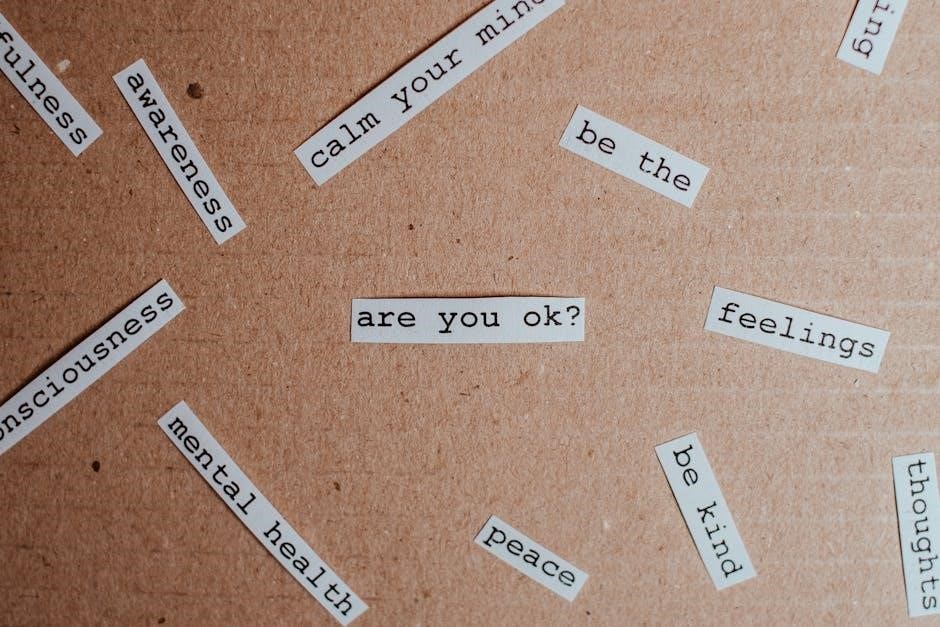overcoming unwanted intrusive thoughts pdf

Intrusive thoughts are spontaneous, distressing ideas that feel alien and uncontrollable, often causing emotional turmoil and interfering with daily life.
These thoughts, though common, can overwhelm individuals, making it crucial to understand their nature and develop strategies for management.
Cognitive Behavioral Therapy (CBT) and practical techniques offer effective ways to regain control and reduce their impact.
By addressing these thoughts proactively, individuals can improve their mental well-being and lead fulfilling lives.
1.1 Understanding the Nature of Intrusive Thoughts
Intrusive thoughts are distressing, repetitive, and unwanted mental images or ideas that feel uncontrollable and alien. They often involve violent, scary, or socially unacceptable content, causing significant anxiety. These thoughts are not reflections of reality or personal desires but are spontaneous and highly emotional. Intrusive thoughts can interfere with daily life, leading to distress and impairment. They are common in anxiety disorders, such as OCD, but can also occur in individuals without mental health conditions. Suppression of these thoughts is often ineffective and may worsen their frequency. Understanding that intrusive thoughts are not actions or intentions is crucial. Recognizing their nature helps individuals acknowledge and address them without judgment, reducing their overwhelming impact.
1.2 The Impact of Intrusive Thoughts on Daily Life
Intrusive thoughts can significantly disrupt daily life, causing emotional distress and impairing functioning. They often lead to excessive worry, anxiety, and avoidance behaviors, as individuals may fear acting on these thoughts. For example, intrusive thoughts about harm can prevent someone from engaging in normal activities, isolating them from loved ones. Sleep disturbances are common, as racing thoughts at night exacerbate fatigue, further worsening mental health. Intrusive thoughts can also strain relationships, as individuals may withdraw to avoid triggering their fears. Without proper management, these thoughts can lead to feelings of helplessness and low self-esteem. Addressing intrusive thoughts through effective strategies is essential to restore emotional balance and improve quality of life. Recognizing their impact highlights the importance of seeking support and implementing coping mechanisms.

Cognitive-Behavioral Therapy (CBT) for Intrusive Thoughts
CBT is a highly effective approach for managing intrusive thoughts by identifying and challenging unhelpful thought patterns, helping individuals develop coping strategies to reduce distress.
2.1 Cognitive Restructuring Techniques

Cognitive restructuring is a core CBT technique that helps individuals identify and challenge unhelpful or distorted thought patterns. By examining the evidence for and against intrusive thoughts, individuals can develop more balanced and realistic ways of thinking. This process involves becoming aware of automatic negative thoughts, labeling them, and then reinterpreting them in a less distressing light. For example, a person might learn to see an intrusive thought as a harmless mental event rather than a reflection of their true desires or intentions. Regular practice of cognitive restructuring reduces the emotional impact of intrusive thoughts and helps individuals respond to them with greater resilience and confidence.
2.2 Behavioral Activation and Exposure Strategies
Behavioral activation involves engaging in meaningful activities to reduce avoidance and improve mood, while exposure strategies systematically confront feared thoughts or situations. Exposure helps individuals learn that intrusive thoughts are harmless and do not lead to catastrophic outcomes. For example, someone fearing they might act on a thought is guided to imagine the scenario without avoiding it, reducing anxiety over time. Behavioral experiments also test beliefs, such as whether suppressing thoughts makes them worse. These techniques help break the cycle of avoidance and reassurance-seeking, fostering confidence and reducing the distress caused by intrusive thoughts. Regular practice enhances emotional resilience and promotes long-term management of unwanted intrusions.

Practical Strategies to Manage Intrusive Thoughts
Practical strategies include mindfulness, grounding techniques, and self-care practices. These methods help reduce anxiety, improve focus, and build resilience against intrusive thoughts effectively.
3.1 Mindfulness and Acceptance-Based Approaches
Mindfulness and acceptance-based approaches focus on observing intrusive thoughts without judgment or attachment. Techniques like meditation and grounding exercises help individuals detach from distressing thoughts, reducing their emotional impact. By practicing non-judgmental awareness, people can learn to accept thoughts as mere mental phenomena rather than reflections of reality or personal failure. This reduces anxiety and the urge to suppress thoughts, which often exacerbates their persistence; Regular mindfulness practice strengthens mental clarity and resilience, enabling individuals to navigate intrusive thoughts with greater ease and self-compassion. Over time, these strategies foster a healthier relationship with one’s mind, promoting emotional balance and stability.
3.2 Journaling and Thought Recording

Journaling and thought recording are powerful tools for managing intrusive thoughts. By writing down intrusive thoughts, individuals can externalize them, reducing their emotional intensity. This practice helps identify patterns, triggers, and recurring themes, providing insight into underlying concerns. Techniques like “thought downloading” allow individuals to release mental burdens onto paper, creating a sense of relief. Journaling also facilitates cognitive restructuring by encouraging individuals to challenge and reframe unhelpful thoughts. Over time, this process fosters greater self-awareness and emotional regulation. Additionally, reflecting on past entries can reveal progress and reinforce coping strategies. Journaling is a practical, accessible method to manage intrusive thoughts effectively, promoting clarity and emotional resilience.
3.3 Lifestyle Changes to Reduce Thought Intrusions
Lifestyle changes play a crucial role in reducing intrusive thoughts by addressing underlying factors that exacerbate them. A balanced diet rich in nutrients, particularly those supporting brain health, such as omega-3 fatty acids and antioxidants, can help stabilize mood and reduce mental fog. Regular physical activity, like walking or yoga, lowers stress hormones and improves emotional resilience. Incorporating relaxation techniques, such as deep breathing or meditation, can calm the mind and reduce the frequency of intrusive thoughts. Additionally, maintaining a structured daily routine, including consistent sleep schedules, helps regulate mental processes. Limiting caffeine, alcohol, and excessive screen time can further minimize triggers. By adopting these lifestyle adjustments, individuals can create an environment that fosters mental clarity and reduces the intrusion of unwanted thoughts.

The Role of Sleep in Managing Intrusive Thoughts
Quality sleep is essential for mental health, as it strengthens cognitive functions and emotional regulation, reducing the intensity and frequency of intrusive thoughts significantly.
4.1 How Sleep Deprivation Exacerbates Intrusive Thoughts
Sleep deprivation significantly worsens intrusive thoughts by impairing cognitive and emotional regulation. Lack of sleep weakens the prefrontal cortex, reducing its ability to suppress unwanted thoughts. This leads to heightened anxiety and stress, making intrusive thoughts feel more overwhelming. Sleep-deprived individuals often experience increased emotional reactivity, making distressing thoughts harder to manage. Additionally, poor sleep disrupts the brain’s ability to process and consolidate emotions, allowing intrusive thoughts to persist. Chronic sleep deprivation can create a cycle where intrusive thoughts worsen sleep quality, further exacerbating the problem. Addressing sleep issues is crucial for reducing the intensity and frequency of intrusive thoughts.
4.2 Improving Sleep Quality to Reduce Thought Intrusions
Enhancing sleep quality is essential for minimizing intrusive thoughts. Establishing a consistent sleep schedule helps regulate the brain, reducing cognitive instability that fuels unwanted thoughts. Creating a calming bedtime routine, such as reading or meditating, signals the mind to unwind. Optimizing the sleep environment by ensuring darkness, quietness, and a cool temperature promotes deeper rest. Limiting screen time before bed and avoiding stimulants like caffeine can prevent disruption of melatonin production, crucial for restorative sleep. Additionally, stress management techniques like mindfulness or deep breathing can further improve sleep quality, indirectly reducing the occurrence of intrusive thoughts; Prioritizing sleep hygiene fosters a healthier mental state, making it easier to manage intrusive thoughts effectively.

Overcoming Shame and Guilt Associated with Intrusive Thoughts
Overcoming shame and guilt involves acknowledging these emotions without self-judgment. Recognizing that intrusive thoughts don’t define your actions can help alleviate the emotional burden. Seeking support and fostering self-compassion are key steps toward healing and reclaiming peace of mind.
5.1 Recognizing the Difference Between Thoughts and Actions
Recognizing the distinction between intrusive thoughts and actual actions is crucial for reducing shame and guilt. Many individuals mistakenly believe that having a thought is equivalent to acting on it, leading to unnecessary self-judgment. Intrusive thoughts are merely mental phenomena and do not reflect a person’s true character or intentions. Understanding that thoughts are not actions can help alleviate the emotional burden. It’s important to remind yourself that intrusive thoughts are common and do not define your morality or behavior. By challenging this false belief, you can begin to separate your identity from these unwanted thoughts, fostering a more compassionate relationship with yourself and reducing the grip of shame and guilt.
5.2 Building Self-Compassion and Reducing Self-Judgment
Building self-compassion is essential for managing intrusive thoughts, as self-judgment often exacerbates emotional distress. Many individuals struggling with intrusive thoughts tend to criticize themselves harshly, believing they are flawed or immoral for having such thoughts. However, cultivating self-compassion involves treating yourself with kindness and understanding, recognizing that intrusive thoughts are common and not a reflection of your true self. By acknowledging that these thoughts are not within your control, you can reduce self-judgment and foster a more nurturing relationship with yourself. Practices like mindfulness, journaling, and affirmations can help reinforce self-compassion, allowing you to respond to intrusive thoughts with empathy rather than criticism. Remember, healing begins with acceptance and kindness toward yourself.

Professional Help and Support Systems
Professional help is crucial for managing intrusive thoughts. CBT and ERP are effective treatments. Mental health professionals offer personalized strategies and support. Support groups also provide community and understanding.
6.1 The Role of Therapy in Managing Intrusive Thoughts
Therapy plays a vital role in managing intrusive thoughts by providing evidence-based strategies to address and reduce their impact. Cognitive-behavioral therapy (CBT) is particularly effective, helping individuals identify and challenge unhelpful thought patterns. Exposure and response prevention (ERP), a CBT technique, is widely used to reduce anxiety associated with intrusive thoughts. Trained therapists create a safe environment to explore these thoughts without judgment, fostering understanding and coping skills. They also help individuals develop emotional resilience and practical tools to manage triggers. Regular therapy sessions can lead to significant improvement over time, enabling individuals to regain control over their mental health. Professional guidance ensures a personalized approach tailored to specific needs.
6.2 Support Groups and Community Resources
Support groups and community resources offer invaluable connections and tools for managing intrusive thoughts. Joining a support group provides a safe space to share experiences, reducing feelings of isolation. These groups, often led by professionals, foster understanding and empowerment. Organizations like the International OCD Foundation host meetings and events tailored to intrusive thoughts. Online forums and peer-led groups also provide accessible support. Community resources, such as hotlines and educational materials, further enhance coping strategies. Engaging with these networks helps individuals build resilience and gain practical advice from others who have similar experiences. Connecting with a community can be a powerful step toward healing and long-term mental well-being.

Recommended Resources for Overcoming Intrusive Thoughts
Explore evidence-based books, online tools, and professional guides to effectively manage intrusive thoughts. Resources like The Anxiety and Worry Workbook and Brain Lock offer practical strategies.
7.1 Books and Guides on Intrusive Thoughts
Several books and guides provide comprehensive strategies for managing intrusive thoughts. The Anxiety and Worry Workbook by David A. Clark offers practical CBT techniques to address intrusive thoughts. Brain Lock by Jeffrey M. Schwartz focuses on managing obsessive thoughts through mindfulness and behavioral change. Overcoming Unwanted Intrusive Thoughts by Sally M. Winston and Martin N. Seif is another excellent resource, offering evidence-based approaches. These books are widely recommended for their actionable advice and compassionate tone. They help individuals understand the nature of intrusive thoughts and provide tools to reduce their impact. Whether you prefer structured exercises or insightful explanations, these guides are invaluable for fostering mental clarity and emotional resilience.

7.2 Online Tools and Worksheets for Managing Intrusive Thoughts
Online tools and worksheets can be invaluable for managing intrusive thoughts. Websites like Cognitive Behavioral Playlists on YouTube offer guided exercises tailored for intrusive thoughts. Platforms such as Therapist Aid provide downloadable worksheets, including thought records and exposure hierarchies. The Mighty app features community support and practical tools for mental health. Additionally, CBT Thought Record Sheets and Exposure Hierarchy Templates are widely available online, helping individuals track and challenge intrusive thoughts. These resources are accessible, flexible, and often free, making them a great supplement to professional guidance. They empower individuals to take proactive steps in managing their thoughts and improving mental well-being.
Overcoming unwanted intrusive thoughts is a journey that requires patience, self-compassion, and consistent effort. By understanding the nature of these thoughts, implementing CBT techniques, and incorporating mindfulness and lifestyle changes, individuals can regain control over their mental well-being. It’s important to remember that intrusive thoughts do not define a person, and seeking professional help is a sign of strength, not weakness. Moving forward, setting realistic goals and practicing daily strategies can lead to lasting improvement. Surrounding oneself with supportive resources and communities further enhances the ability to manage intrusive thoughts effectively. Taking the next step toward healing is a courageous move toward a more balanced and peaceful life.